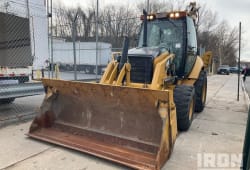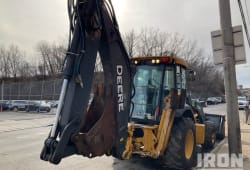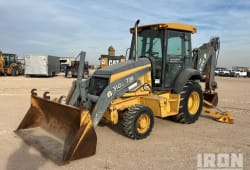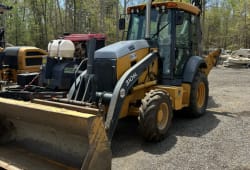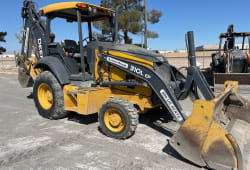Mini Loader Weight Limits: Guidelines, Restrictions, and More for Transportation and Operation
8 Min read
)
October 16, 2023
Mini loaders, also known as compact loaders or skid steer loaders, are versatile and powerful machines widely used in construction, landscaping, agriculture, and various other industries. These machines come in different sizes and capacities, making them suitable for a range of tasks. However, understanding mini loader weight limits for both transportation and operation is crucial to ensure safety and maximize efficiency. If you are looking for the same information, then you are on the right page. Here, we will explore the factors that affect these loader weight limits, how to determine these limits, and best practices for safe transportation and operation.
A Quick Glance on Mini Loader Weight Limits
They are compact workhorses that are prized for their ability to tackle a wide range of tasks. However, to ensure safety and efficient operation, it's crucial to understand and adhere to the weight limits associated with mini loaders. This article highlights the significance of weight restrictions for these machines, both in terms of transportation and operation.
Weight Classification of Different types of Mini Loaders
They are typically classified into three categories based on their weight:
Mini Skid Steer Loaders (under 2,000 lbs): These compact loaders are lightweight and versatile, suitable for small-scale tasks such as landscaping and gardening.
Compact Skid Steer Loaders (2,000 to 4,000 lbs): These loaders are more robust and are often used in construction and agriculture for medium-sized projects.
Compact Track Loaders (over 4,000 lbs): Compact track loaders are the heaviest of the three and are designed for more substantial tasks, such as excavation and demolition.
How to Navigate Mini Loader Weight Restrictions?
They come in various sizes and capacities, and each model has its own set of weight limits. These limits are determined by factors such as the machine's specifications and attachments. For example, a larger mini loader equipped with a heavier bucket or other attachments will have different weight restrictions compared to a smaller, more compact model. These restrictions are in place to ensure safe and effective operation while preventing damage to the machine and its surroundings.
Why is it Important to Know Mini Loader Weight Limits?
:format(webp))
Understanding and adhering to these weight limits is crucial for several reasons. First and foremost, exceeding these limits can lead to accidents, machine damage, and increased wear and tear on components. Additionally, disregarding these constraints may result in soil compaction or damage to underground utilities. Knowing the weight limits of your mini loader and its attachments ensures the safety of operators, bystanders, and the environment.
Important Weight Limit Considerations for Mini Loader Transportation
Transporting them requires a comprehensive understanding of transportation weight limits. These limits are typically defined by local regulations, and exceeding them can lead to legal consequences, including fines. It's crucial to ensure that the trailer or vehicle used for transport is rated to handle the weight of the it and its attachments. Furthermore, it's essential to secure the load correctly to prevent any shifting during transit.
Weight Guidelines for Mini Loader
Mini loaders come with manufacturer-provided weight guidelines that must be strictly adhered to. These guidelines specify the maximum allowable weight for the machine and its attachments, which include buckets, forks, grapples, hydraulic hammers, and more. Operators must be familiar with the manual and adhere to the recommended guidelines for each specific attachment used.
Mini Loader Weight Constraints for Operation
Operating a mini loader within its weight constraints is vital to preserving the machine's longevity and ensuring safety on the job site. Exceeding these limits can lead to increased wear and tear on components, reduced efficiency, and, in extreme cases, catastrophic failure. Operators must understand the weight limits of their equipment and make responsible decisions when selecting attachments and undertaking tasks.
The strain imposed on the engine, hydraulics, and other essential parts can result in costly maintenance and repairs, negatively impacting your operational costs.
Moreover, disregarding weight constraints can have dire consequences in terms of safety. Overloaded mini loaders are at a heightened risk of tipping over, causing accidents that can result in severe injuries or fatalities. Maintaining a deep understanding of your equipment's weight limits is fundamental to creating a secure work environment and protecting the well-being of your team.
To operate a mini loader effectively, operators must not only respect these weight constraints but also make informed decisions when selecting attachments for specific tasks. Choosing attachments that align with the machine's load capacity ensures optimal performance and minimizes undue stress on the loader, promoting safer and more efficient operations.
9 Tips for Transporting Mini Loaders Within Legal Limits
Transporting mini loaders within legal weight limits necessitates careful planning and compliance with regulations. Here are some essential tips to ensure you remain within the law while moving your equipment:
- Know Local Regulations: Different regions and countries may have varying regulations regarding the transportation of heavy equipment. It's crucial to understand and comply with the local laws and weight restrictions.
- Check Vehicle Capacity: Ensure that the truck or trailer used for transport is capable of safely carrying the combined weight and its attachments. The vehicle's weight capacity should meet or exceed the total weight you're transporting.
- Secure the Load: Properly secure to the trailer or truck to prevent any shifting during transportation. High-quality straps, chains, and tie-downs should be used to secure the load safely.
- Evenly Distribute Weight: To maintain balance during transport and avoid instability, ensure that the weight and its attachments is distributed evenly across the trailer or truck.
- Understand Axle Limits: Be aware of axle weight limits, which vary depending on the number of axles your vehicle has. Distribute the load appropriately to stay within these limits.
- Get Necessary Permits: Depending on the size and weight, you may need special permits for transportation. Check with local authorities to determine if permits are required for your specific load.
- Regular Maintenance: Regularly inspect your trailer or transport vehicle for signs of wear and tear, and perform maintenance as needed to ensure safe and efficient transportation.
- Stay Informed: Stay updated on any changes in regulations and laws related to the transportation of heavy equipment in your area. Compliance is essential for avoiding legal issues.
Weight Regulations for Mini Loader
Regulations concerning the weight of them and other heavy equipment can vary based on factors like road classifications and bridge weight limits. In many cases, you will need to consult local transportation authorities or obtain permits to transport them legally. Being aware of these regulations and adhering to them is essential to avoid fines and legal complications.
Avoiding Fines
Exceeding weight limits for them during transportation can lead to significant fines, which can significantly impact your business's profitability. Fines are imposed to deter unsafe transportation practices and ensure the integrity of road infrastructure. By adhering to weight regulations and implementing best practices for load securement, you can minimize the risk of incurring fines. Moreover, it's essential to recognize that these fines not only affect your bottom line but can also damage your company's reputation. Penalties and legal troubles resulting from weight limit violations can lead to increased insurance costs and hinder your ability to secure contracts in the future. Ensuring compliance with weight limits is not only a legal obligation but also a prudent business strategy to safeguard your financial stability and professional standing.
Maximizing Efficiency While Adhering to Mini Loader Weight Limits
Operating them within their weight limits doesn't just ensure compliance with the law and safety but also promotes efficiency. By utilizing the appropriate attachment and configuration for the job, operators can work more effectively and enhance productivity. Understanding the weight limits of your mini loader allows for optimal resource allocation and a safer work environment, leading to cost savings and customer satisfaction. By maximizing efficiency while adhering to weight restrictions, you can provide high-quality services and maintain a strong reputation in your industry. This balanced approach not only benefits your business but also ensures the longevity of your equipment.
Conclusion
Understanding these weight limits for both transportation and operation is essential to ensure the safety of workers and the efficient use of these versatile machines. Operators must be well-trained, and load limits should always be respected. Proper transportation practices, including the selection of suitable trailers and adherence to legal requirements, are crucial for safe transit. Ultimately, prioritizing safety and adhering to best practices will maximize the utility of mini loaders while minimizing risks and accidents in various industries.

